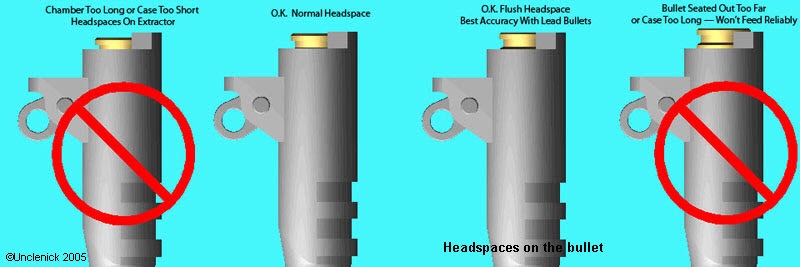Here is one of
Dusty Bannisters posts about the "Dowel method" to determine OAL:
{He/Dusty, posted while I was typing this post up.}
Cleaning rod/dowel method of finding cartridge OAL
This is what I use for my guns to determine the max OAL and this eliminates any question of the crimp, incorrect case prep, or other operator induced error.
This method works well on rifles and single shot pistols as well as Semi-autos. You can use a flat tipped cleaning rod, or flat tipped dowel rod. You will also need a sharp pointed pencil, a short dowel and a bullet sized but clean, of the type you are going to load.
For Rifles
Make sure the chamber is empty. Close the bolt, and be sure the firing pin is retracted into the bolt. Insert the dowel or cleaning rod and hold it against the face of the bolt. Mark the rod at the face of the muzzle. Remove rod, open bolt and remove it from the action. Insert the bullet into the breech and hold it snug into the rifling. While in that position insert the dowel or rod again, and with it firm against the nose of the bullet, mark the rod at the face of the muzzle.
The distance between the center of those two marks is the max cartridge OAL for that rifle, with that bullet sized to that diameter.
For Semi-autos
Remove the barrel from the slide and make sure it is clean and free of leading or other debris in the barrel and chamber. The dowel or cleaning rod needs to be longer than the barrel. Hold the barrel, muzzle up, and place the barrel hood on a flat surface like a table top. Insert the dowel or rod from the muzzle and mark the rod exactly flush with the muzzle. Remove the rod and insert the bullet you intend to use into the chamber and lightly press and hold it in place with the short dowel. Place the assy muzzle up on the flat surface. Insert the rod/dowel into the muzzle so it rests on the nose of the bullet and again mark the rod exactly flush with the muzzle. Remove and set the barrel aside. The distance on the center of the two lines is the cartridge OAL. Seat a dummy round to this length, or slightly shorter and begin to apply the taper crimp until the dummy passes the plunk test. This is the optomum cartridge OAL length for this bullet in this gun.
You may need to adjust the seater to shorten the OAL if this does not feed from the magazine, but generally this will be a great fit. Remember, if you seat and crimp in one step, you might force a slight ridge ahead of the case mouth and that will screw up your seating.
Dusty
Source:
http://castboolits.gunloads.com/show...=1#post3560663













 Reply With Quote
Reply With Quote















